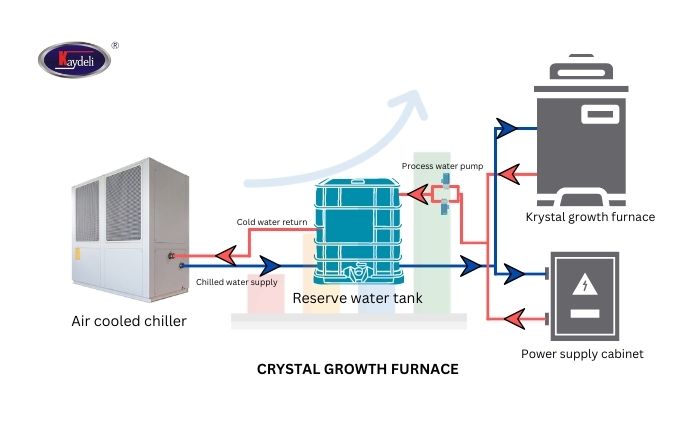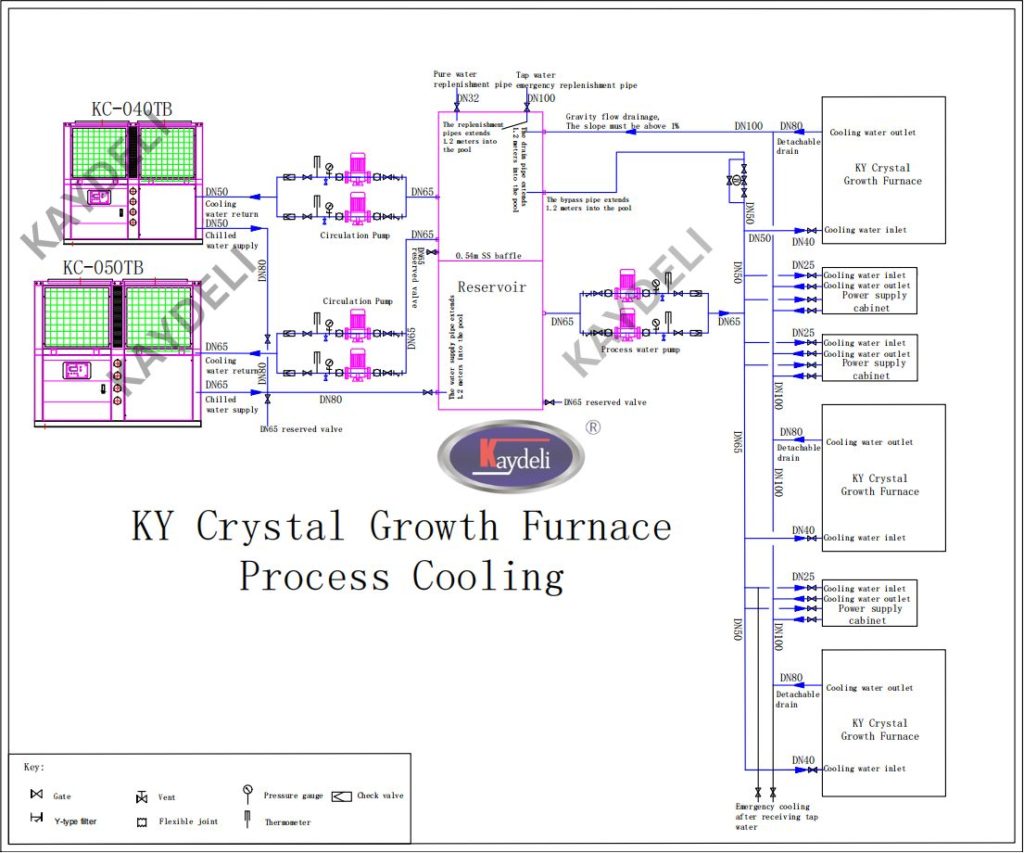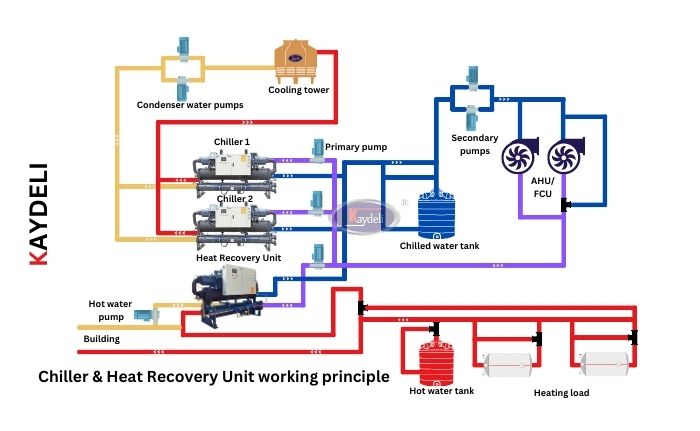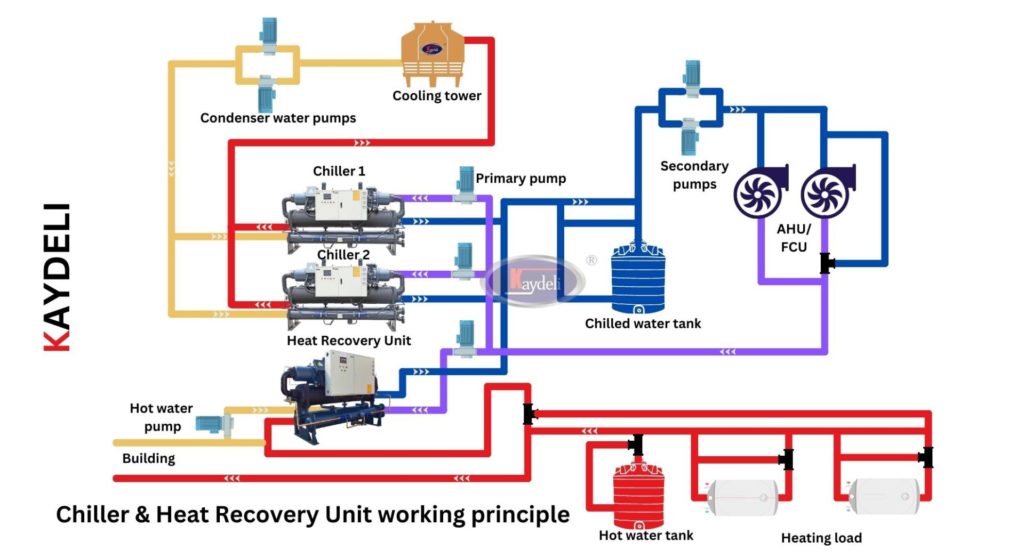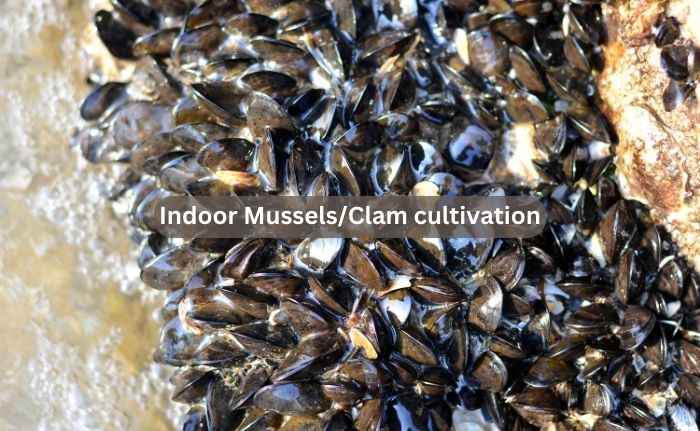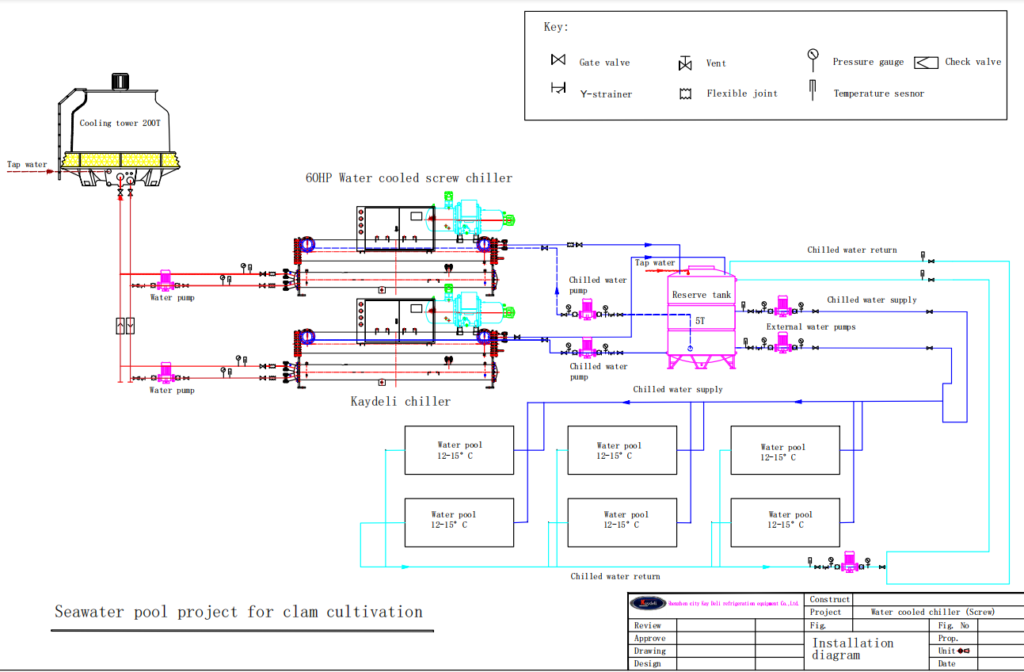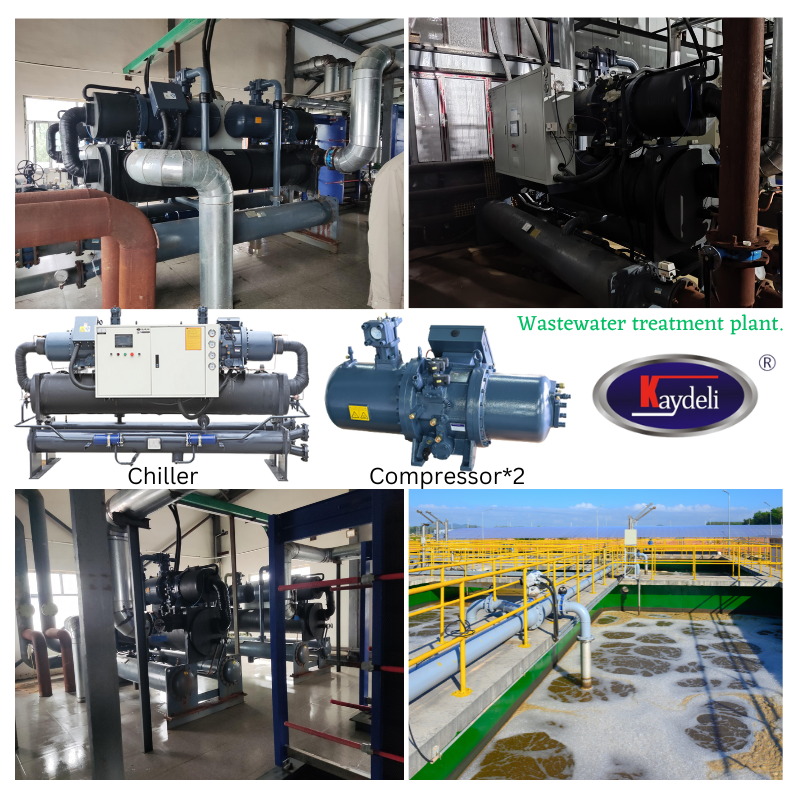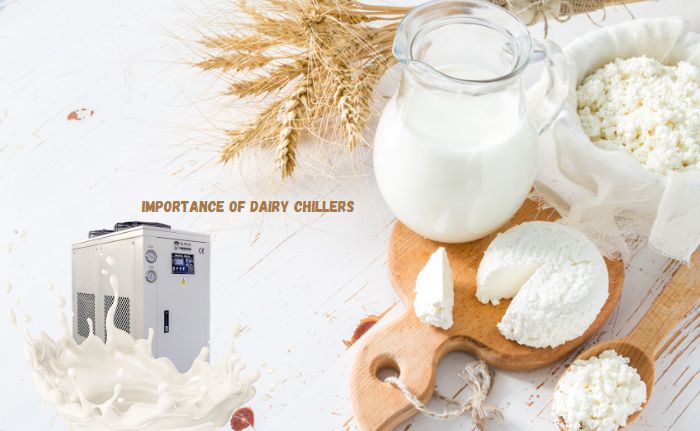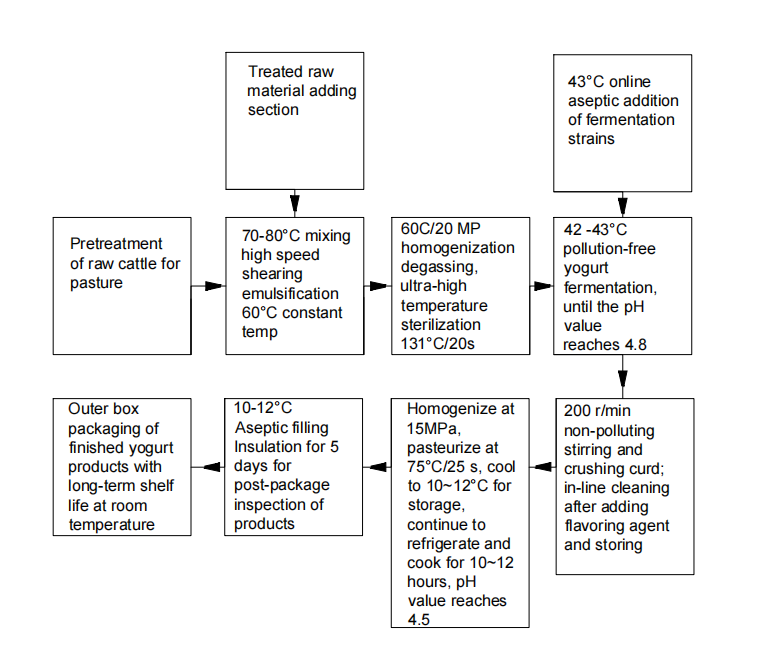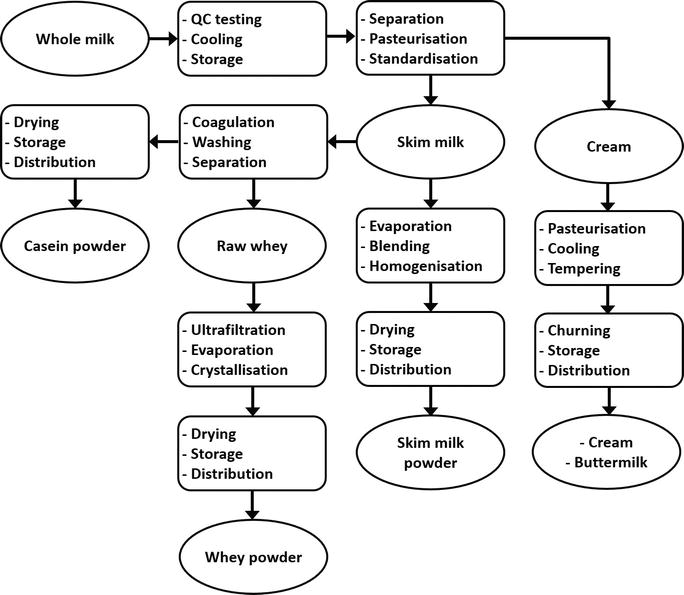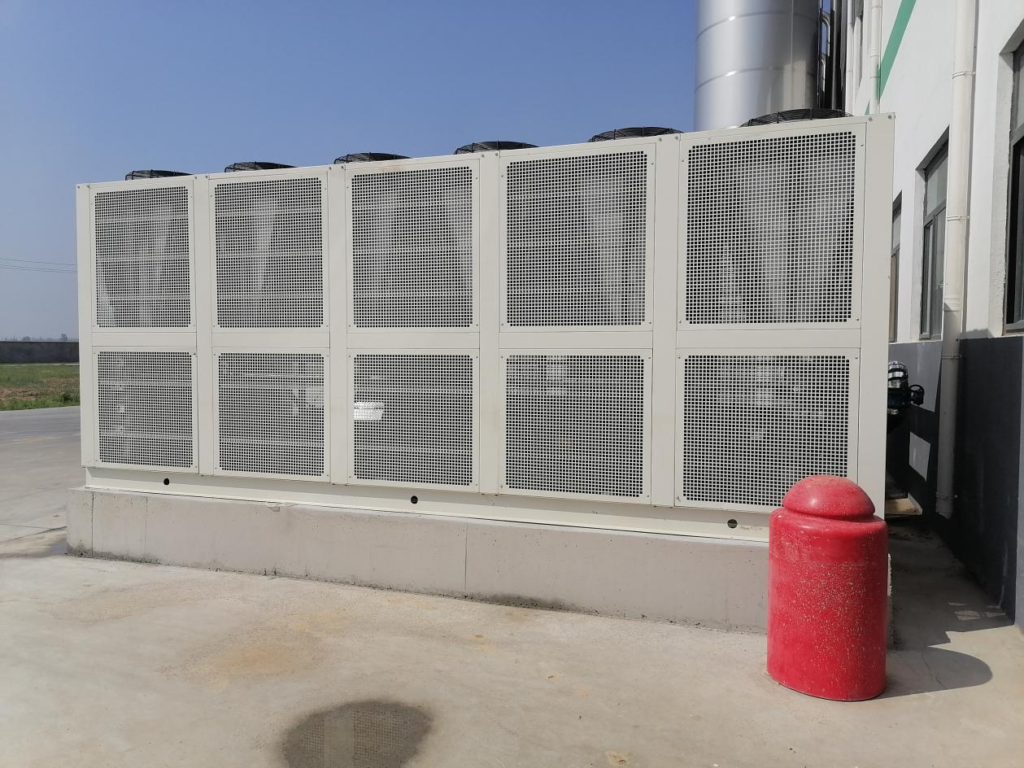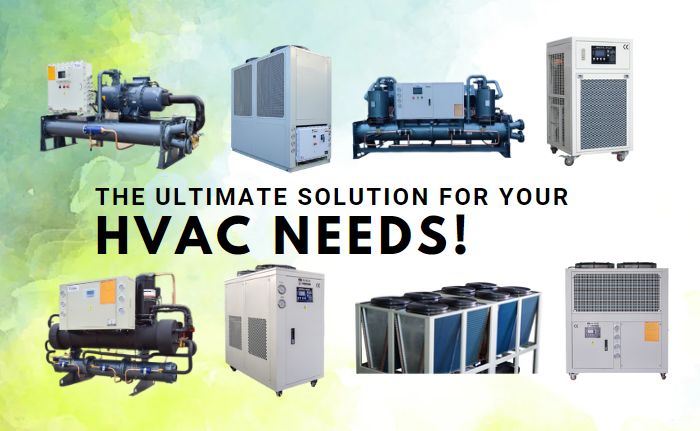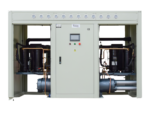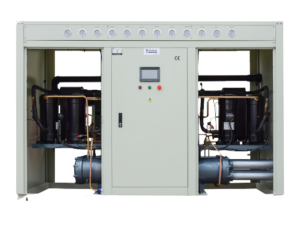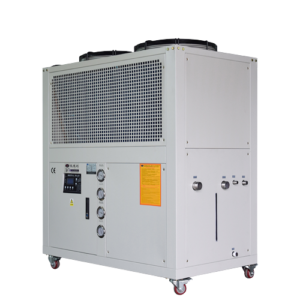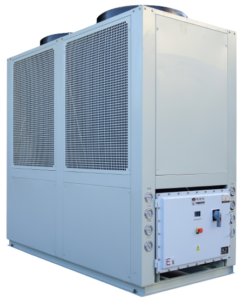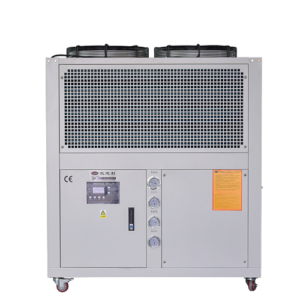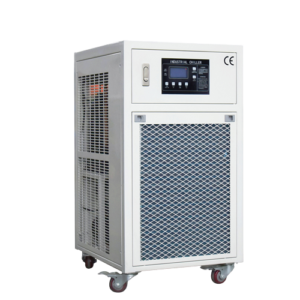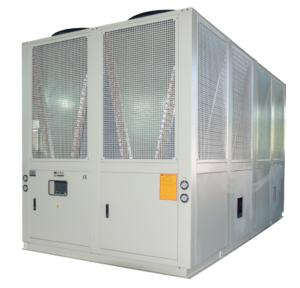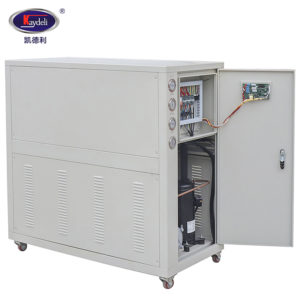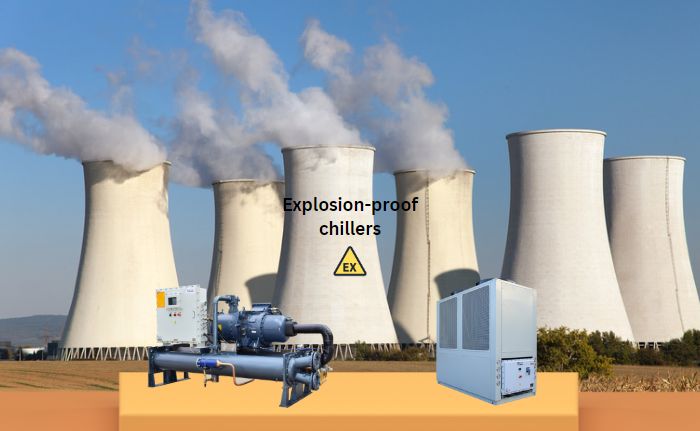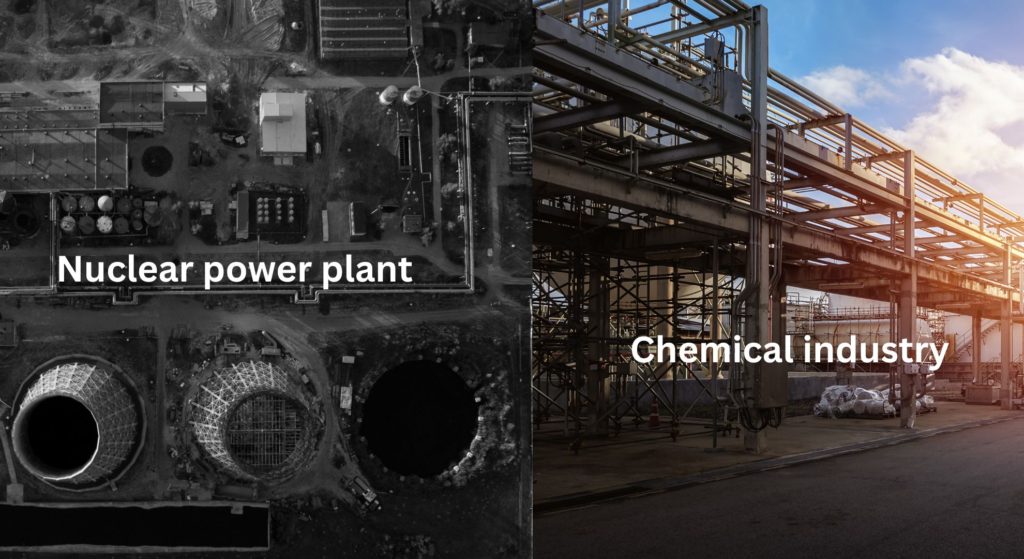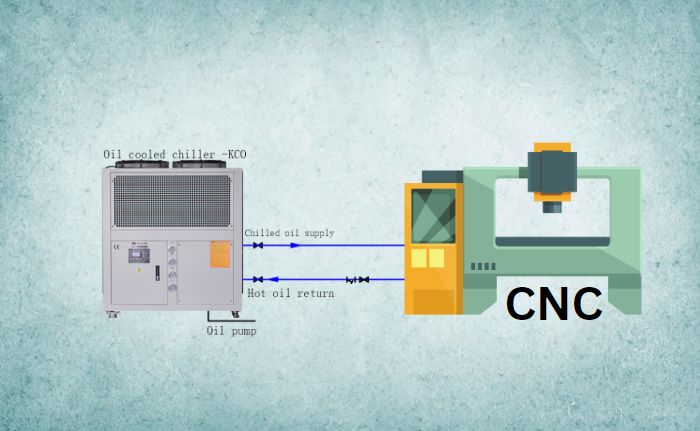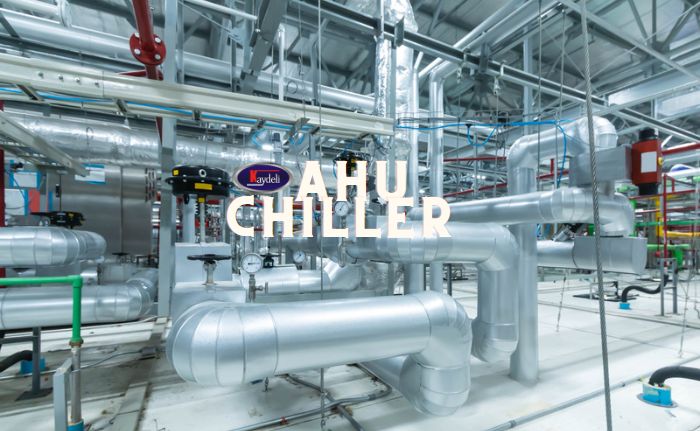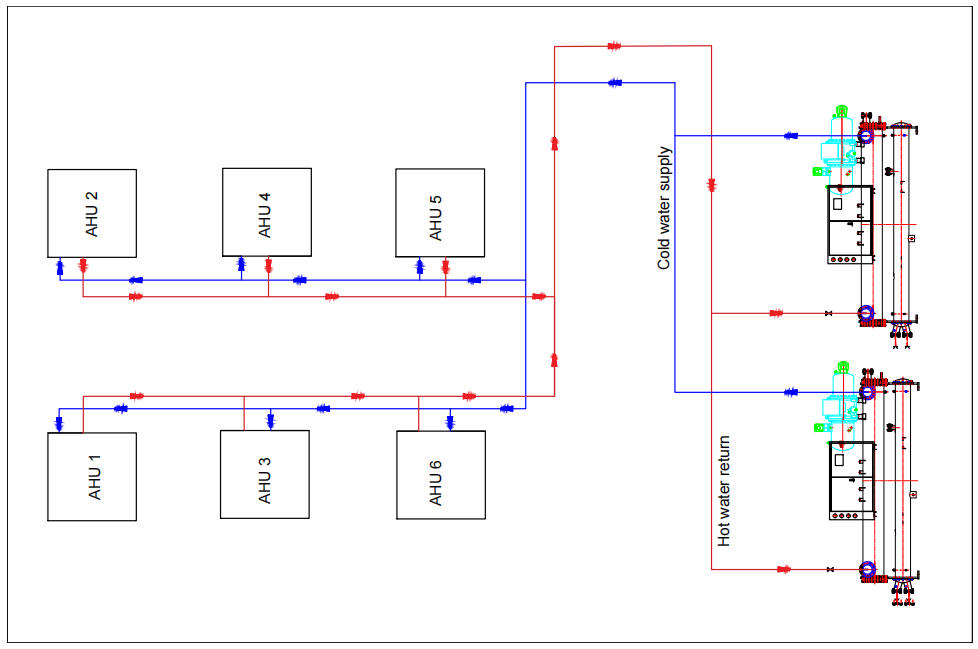Advanced Cooling with Heat Pump Chiller
An air-cooled heat pump chiller is a type of HVAC system that uses outdoor air as the source for both heating and cooling. It works by absorbing heat from the outdoor air and transferring it indoors to provide warmth during colder weather, and by removing heat from indoors and transferring it outside to provide cool air during hotter weather. The system uses a refrigerant to facilitate the heat transfer process and can be an efficient and cost-effective way to regulate indoor temperature.
In a commercial building, an air-cooled heat pump chiller works by following these basic steps:
- The outdoor unit of the chiller absorbs heat from the surrounding air using a refrigerant. This heat energy is then transferred to the indoor unit through the refrigerant lines.
- The indoor unit of the chiller uses heat energy to warm up the air in the building through a process called heat exchange. This warmed air is then circulated through the building’s ductwork to provide heating.
- During the summer months, the process is reversed to provide cooling. The indoor unit absorbs heat from the indoor air and transfers it to the outdoor unit, which then releases it into the surrounding air.
- The chilled air is then circulated through the building’s ductwork to provide cooling.
Overall, an air-cooled heat pump chiller provides both heating and cooling by transferring heat energy between the indoor and outdoor units using a refrigerant. This allows for efficient temperature control in commercial buildings.

There are several advantages to using air-cooled heat pumps, including:
- Energy efficiency: Air-cooled heat pumps are highly energy efficient, as they use the surrounding air to provide heating and cooling. This can result in lower energy bills and reduced carbon emissions.
- Easy installation: Air-cooled heat pumps are easy to install and require less space than other HVAC systems, as they do not require a separate cooling tower or water source.
- Low maintenance: Air-cooled heat pumps require less maintenance than other HVAC systems, as they have fewer moving parts and do not require regular water treatment.
- Flexibility: Air-cooled heat pumps can be used in a variety of settings, including commercial buildings, residential homes, and industrial facilities.
- Cost-effective: Air-cooled heat pumps can be a cost-effective option for heating and cooling, as they can provide both functions with a single system.
Overall, air-cooled heat pumps offer several advantages over other HVAC systems, including energy efficiency, easy installation, low maintenance, flexibility, and cost-effectiveness.
Please contact Kaydeli if you have an interest in any type of Industrial chillers. You can also check out videos about industrial chillers here.
Temperature Control System for Crystal Growth Furnace
What is a crystal growth furnace system?
A crystal growth furnace system is a machine used to grow crystals in a controlled environment. It typically consists of a furnace, which heats the material to the desired temperature, and a chamber where the crystal growth occurs. The system is designed to maintain specific temperature, pressure, and atmospheric conditions to ensure optimal crystal growth. These systems are widely used in the semiconductor, electronics, and materials science industries.
How does it work?
The working principle of a crystal growth furnace system is based on the controlled heating and cooling of a material to promote crystal growth. As mentioned earlier the system typically consists of a furnace, which heats the material to a high temperature, and a chamber where the crystal growth occurs. The material is melted and then slowly cooled under controlled conditions to promote the formation of a crystal lattice structure. The rate of cooling and other environmental factors such as pressure and gas composition can be adjusted to optimize the crystal growth process. Once the crystal has formed, it can be harvested and used for various applications.
Why a chiller is required for the process?
A chiller is required in a crystal growth furnace system to maintain a stable temperature within the system. The furnace heats the material to a high temperature, but it is important to cool the surrounding environment to prevent unwanted reactions and maintain a stable temperature for crystal growth. A chiller circulates a coolant, typically water, through the system to remove excess heat and maintain a stable temperature. The temperature of the coolant can be adjusted to control the temperature of the system, allowing for precise control of the crystal growth process. Without a chiller, it would be difficult to maintain a stable temperature and optimize crystal growth.
Here is one of our recent projects for an African crystal growth company.
In this project, Kaydeli used two of their air-cooled chillers KC-040TB and KC-050 TB to accomplish the project.
A total of five crystal growth furnaces are installed in this process, three KY crystal growth furnaces, and two GT crystal growth furnaces. The maximum production load operation does not exceed three crystal growth furnaces, and each cycle corresponds to the maintenance of different crystal growth furnaces.
The cooling water demand for a single unit of KY crystal growth furnace equipment is: 6m³/h, the constant temperature of the cooling water supply is 28°C±1°C, and the water inlet pressure of the crystal growth furnace is 0.2MPa-0.22MPa. The gravity flow returns to water, and the water inlet pressure of the power cabinet 0.2MPa-0.3MPa. The outlet water temperature rises by 5~7°C.
Here is the design of a set of cooling circulating water systems, using two air-cooled industrial chillers to cool down the normal temperature water in the 12 cubic reservoirs to the set temperature, and then the cold water in the reservoir is delivered to the crystal growth furnace equipment by the process water pump.
Two air-cooled industrial chillers are selected, one with a cooling capacity of 113.1KW (the other one has a cooling capacity of 141.4KW), an overall unit composed of four compressors, four independently operating refrigeration systems, process water pumps, air conditioning circulation pumps, and, centrifugal pumps. The material of the water supply and return pipes is 304 stainless steel(SS), and each device is equipped with 304 stainless steel (SS) valves. The air-cooled industrial chiller integrates the refrigeration system, water tank, and water pump for easy use and operation. The unit is compact and occupies a small area. It can be used when it is connected to water and electricity.
Intelligent control, using a high-precision LCD digital controller, can intuitively and accurately measure the outlet water temperature, the operation panel can intuitively display the operation and fault status of the compressor, water pump, and refrigeration system at a glance. Only pressing the start and stop buttons can run the equipment automatically. Simple operation and convenience.
Please feel free to contact Kaydeli for any kind of support in this field as well as for any Industrial chiller requirements.
Unlocking Energy Efficiency with Kaydeli Heat Recovery Units
In a world where energy conservation and sustainability have become paramount, innovative solutions are constantly emerging to meet the demands of various industries. One such solution is the Kaydeli heat recovery unit – a game-changer that is revolutionizing energy management in manufacturing plants, data centers, power generation facilities, commercial buildings, and hotels. This blog will delve into the working principle behind Kaydeli heat recovery units and explore their diverse applications in different sectors.
Kaydeli heat recovery units are designed to capture waste heat generated during various industrial processes and transfer it to a separate medium such as water or air. This recovered heat can then be repurposed for other applications within the facility, leading to substantial energy savings.
Working principle of heat recovery unit:
An industrial heat recovery unit chiller works on a similar principle, but it utilizes the recovered heat to produce chilled water instead of re-purposing it for other applications. The working principle of an industrial heat recovery unit chiller involves the use of a heat exchanger to transfer the waste heat from the exhaust gases or liquids to a refrigerant.
The refrigerant then undergoes a cycle of compression and expansion to produce chilled water, which can be used for air conditioning or other cooling applications within the facility. This process not only saves energy but also reduces the load on the facility’s cooling system, leading to further energy savings.
The heat reclaim chiller has the capability to generate water temperatures ranging from 48℃ to 65℃ during its operation. Although this temperature range is adequate for many applications, some may require a continuous supply of hot water. Once the building’s cooling load is met, the heat recovery chiller must be turned off to prevent over-cooling of the chilled water loop, which results in a lack of hot water generation.
To address this issue, a system similar to the heating load section in the image should be considered. This system captures heat from the heat recovery chiller when it is available and supplies hot water at the desired temperature for the specific application.
Kaydeli heat recovery units have diverse applications in various industries. Some of the common application fields of Kaydeli heat recovery units are:
Manufacturing Plants: Kaydeli heat recovery units can be used in manufacturing plants to capture waste heat generated during production processes and repurpose it for other applications such as heating water or air conditioning. This can lead to significant energy savings and reduce the plant’s carbon footprint.
Data Centers: Data centers consume a significant amount of energy to power and cool their servers. Kaydeli heat recovery units can be used to capture the waste heat generated by the servers and repurpose it for other applications such as heating water or powering the facility’s cooling system.
Power Generation Facilities: Kaydeli heat recovery units can be used in power generation facilities to capture waste heat generated during the power generation process and repurpose it for other applications such as heating water or air conditioning. This can lead to significant energy savings and reduce the facility’s carbon footprint.
Commercial Buildings: Kaydeli heat recovery units can be used in commercial buildings to capture waste heat generated by HVAC systems and repurpose it for other applications such as heating water or air conditioning. This can lead to significant energy savings and reduce the building’s carbon footprint.
Hotels: Kaydeli heat recovery units can be used in hotels to capture waste heat generated by HVAC systems and repurpose it for other applications such as heating water or air conditioning. This can lead to significant energy savings and reduce the hotel’s carbon footprint, while also providing a comfortable environment for guests.
Indoor Clam/mussels Cultivation with Cutting-Edge chillers
Introduction
Indoor clam cultivation has rapidly gained popularity in recent years, catering to the increasing demand for sustainable seafood. To meet the unique requirements of this specialized cultivation process, Kaydeli, a renowned industry leader in HVAC equipment manufacturing, has introduced its state-of-the-art Seawater Chiller. With its exceptional features and innovative design, this chiller is transforming the clam cultivation industry, ensuring optimal water temperature control and addressing the challenges of seawater corrosion.
Unleashing the Power of Seawater Chiller in Clam Cultivation
The Kaydeli Seawater Chiller is specifically engineered to provide precise temperature control for indoor clam cultivation. This advanced system allows growers to replicate ideal seawater conditions, creating an environment conducive to the growth and development of clams throughout all stages of their life cycle.
- Specialized Titanium Tube Technology
The Kaydeli Seawater Chiller is equipped with a special titanium tube in the evaporator. This is a game-changer for the industry as seawater is highly corrosive, posing a significant challenge for equipment durability and efficiency. The titanium tube ensures the chiller’s longevity and reliability, making it suitable for long-term use in saltwater applications.
- Different Type For More Precision
Kaydeli also offers different types of chillers to make sure your project is getting what it requires. Air cooled screw/scroll type seawater chiller, Water cooled screw/scroll type seawater chiller, and also the refrigerant is choose-able, adjustable temperature range.
- 3. Optimal Temperature Regulation
Maintaining consistent water temperatures is crucial for successful clam cultivation. The Kaydeli Seawater Chiller utilizes advanced temperature control technology, allowing growers to precisely manage and monitor water temperatures to suit specific clam species and growth stages. This capability ensures ideal conditions for clam health, growth, and productivity.
Here are some of Kaydeli’s recent works,
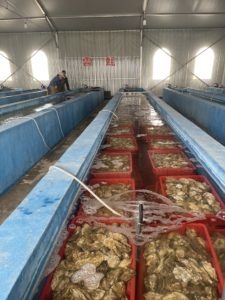
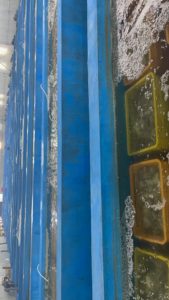
Mussels and clams pool (Temperature 12~15℃)
- 4. Energy Efficiency and Cost Savings
The Kaydeli Seawater Chiller incorporates cutting-edge energy-saving features, minimizing energy consumption without compromising performance. This not only helps reduce operating costs but also contributes to a more sustainable and environmentally friendly cultivation process.
- 5. Customized Solutions
Kaydeli understands that every clam cultivation operation is unique. To cater to diverse needs, the Seawater Chiller offers a range of customizable options. Whether it’s size requirements, control systems, or additional components, Kaydeli works closely with growers to design tailored solutions that align perfectly with their requirements.
How to install
Additionally
The Kaydeli seawater chiller is incredibly energy-efficient. It uses advanced technology to minimize energy consumption while still delivering top-notch performance. This means you can save money on your energy bills while still enjoying all the benefits of a high-quality seawater chiller.
Conclusion
The Kaydeli Seawater Chiller is revolutionizing indoor clam cultivation with its innovative features and commitment to excellence. By providing precise temperature control, combating seawater corrosion with its anti-corrosion technology, and ensuring energy efficiency, this state-of-the-art chiller empowers growers to achieve optimal productivity, sustainability, and quality in their clam cultivation operations. With Kaydeli’s Seawater Chiller, the future of indoor clam farming looks promising, opening up new possibilities for meeting the growing demand for sustainable seafood while safeguarding the environment.
To learn more about Kaydeli’s Seawater Chiller and how it can enhance your clam cultivation process, visit our website or contact our team of experts today.
How Wastewater Treatment Chillers Work in a plant
Wastewater treatment is a vital process that ensures that water is safe to be released back into the environment. One important aspect of wastewater treatment is the use of chillers to cool the water before it is treated. In this article, we’ll take a closer look at how wastewater treatment chillers work and why they’re important in the process.
How Wastewater Treatment Chillers Work
Wastewater treatment chillers work by cooling the water that is being treated. The chiller removes heat from the water, which helps to slow down the growth of bacteria and other microorganisms in the water. This makes it easier to treat the water and remove any contaminants.
Kaydeli’s water-cooled chiller is an example of a chiller that can be used in wastewater treatment. This chiller uses a refrigeration cycle to remove heat from the water. The refrigeration cycle works by compressing a refrigerant gas, which causes it to become hot. The hot gas then flows through a condenser, where it releases heat and becomes a liquid. The liquid refrigerant then flows through an expansion valve, which causes it to become cold and turn back into a gas. The cold gas then flows through an evaporator, where it absorbs heat from the water and turns back into a liquid. This cycle repeats, continuously removing heat from the water.
Why Wastewater Treatment Chillers are Important
Wastewater treatment chillers are important because they help to ensure that the water being treated is at the right temperature for effective treatment. If the water is too warm, bacteria and other microorganisms can grow too quickly, making it more difficult to treat the water effectively. By cooling the water, wastewater treatment chillers make it easier to remove contaminants and ensure that the water is safe to be released back into the environment.
In addition to improving the effectiveness of wastewater treatment, chillers can also help to reduce energy costs. By cooling the water before it is treated, less energy is needed to treat the water effectively. Kaydeli’s water-cooled chiller is designed to be energy-efficient, which can help to reduce operating costs for wastewater treatment facilities.
Conclusion
Wastewater treatment chillers play an important role in ensuring that water is safe to be released back into the environment. By cooling the water before it is treated, these chillers help to slow down the growth of bacteria and other microorganisms in the water, making it easier to remove contaminants. Kaydeli’s water-cooled chiller is an example of a chiller that can be used in wastewater treatment, and its energy-efficient design can help to reduce operating costs for wastewater treatment facilities.
In New Zealand: The Secrets to Safe and High-Quality Milk
Milk Production Cooling Project, Nutrizone Limited (New Zealand)
Industrial chillers play a pivotal role in the dairy production industry, ensuring the quality and safety of dairy products. With stringent temperature requirements, maintaining optimal cooling conditions is essential throughout the production process. Industrial chillers are used to cool milk, cream, and other dairy ingredients, preserving their freshness and preventing potential spoilage. These chillers also aid in the production of dairy products like yogurt, cheese, and ice cream, enabling precise temperature control during fermentation, aging, and freezing processes. By utilizing reliable chillers, dairy producers can uphold product integrity, extend shelf life, and meet strict regulatory standards, ultimately delivering high-quality and safe dairy products to consumers worldwide.
In this article, we will discuss the industry and the application of the Kaydeli chiller in the yogurt and other dairy production process. We hope it will be helpful for industry partners to choose chillers.
Yogurt is too common in our daily life! In milk production, the chiller is one of the essential pieces of equipment, usually used as shared equipment, and is closely related to the equipment in all related production links of yogurt.
Yogurt production process
New Zealand Nutrizone Limited is a New Zealand food group specializing in the production of milk products and food. Through industry partners, they found the Kaydeli Foreign Trade Department, which is also concerned about the Kaydeli brand chiller, Because there were many refrigeration projects for milk, food, and beverages are been supplied with Kaydeli industrial chillers.
For example, Shandong Dongying Milk Cooling Project, KEKO (Malaysia), the Coca-Cola beverage production project in Huizhou, etc.
They shared the specific parameter requirements of the chiller, not only to meet the production needs but also to meet the safety and health requirements, to be reliable in operation and economical in cost.
According to the specific needs of customers, our engineering team learned about the milk production process of the customer’s factory and advised two air-cooled twin-screw chillers, KDCS-160LLA and KDCS-180DLA.
The production equipment is mainly composed of raw milk storage and pretreatment equipment, mixing treatment equipment, ultra-high temperature sterilization equipment, yogurt fermentation equipment, yogurt pasteurization equipment, yogurt aseptic filling equipment, CIP cleaning equipment, etc.
The chillers are used in milk production and can be used as the cold source of the low-temperature cooling system to control the temperature of the production process and control the growth of bacteria within a certain speed. The low-temperature chiller can quickly cool down and ensure a suitable temperature environment for milk production.
Here is the flow chart below of the dairy production,
Dairy production process
In milk processing and production, there are many temperature links involved. One of the most typical applications is low temperature. In the process of the milk collection system, for the cooling process of fresh milk, the fresh milk needs to be quickly cooled to Below 1~4 degrees, otherwise it will be detrimental to the quality of milk.
In the low-temperature process of cooling milk, the equipment sends milk to the other side of the refrigeration system through stainless steel refrigeration equipment (customized food-grade materials), and exchanges heat with frozen water to achieve rapid cooling to the temperature required by the process.
The Kaydeli chiller research and development team fully understands the importance of milk cooling, and provides a set of more practical, energy-saving, and convenient refrigeration engineering solutions, which have the following points:
Low refrigerant losses: Kaydeli chillers are dedicated to reducing refrigerant loss to the environment, making our equipment more productive and efficient.
Less energy to operate: Kaydeli chillers use less energy and our economical solutions reduce energy consumption, reducing operating costs and increasing production capacity for you.
Maintenance: The refrigerating unit is easier to maintain. By using a heat exchanger that is easy to clean, the maintenance time is reduced, which saves huge manpower, material, and financial resources for the milk enterprise.
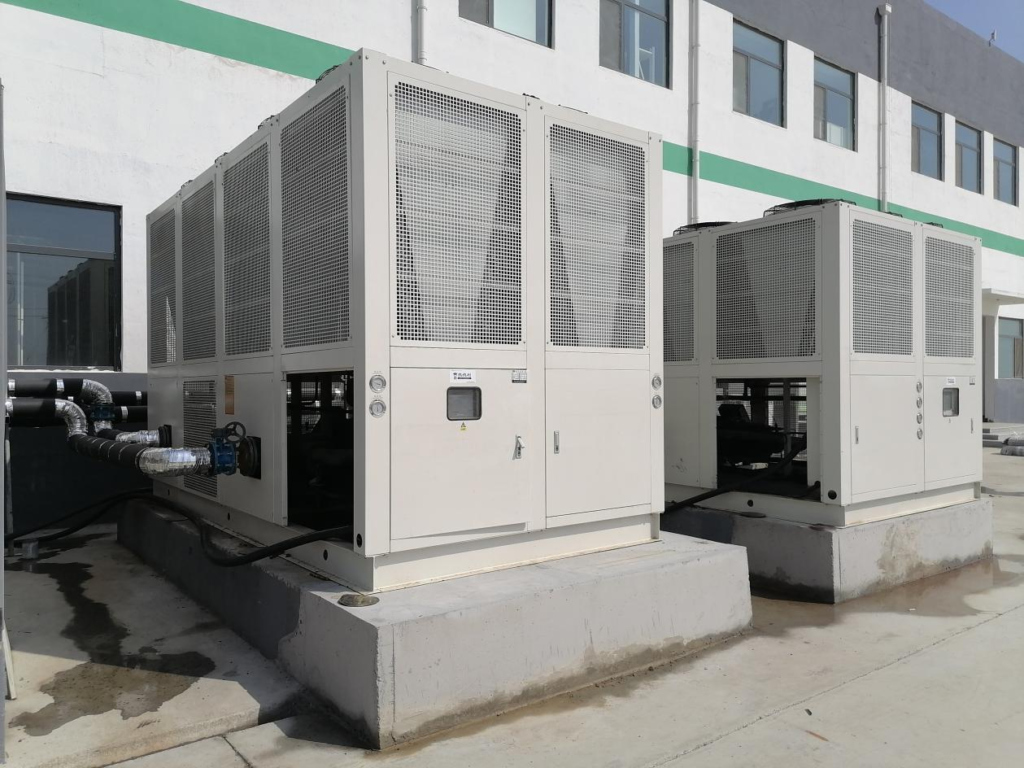
KDCS-160LLA, and KDCS-180DLA, with temperature adjustable ranges of (7°C~30°C), and (0℃~30°C).
The following introduces the characteristics of the Kaydeli chiller, which is used in the milk cooling system:
The general cooling system is composed of an air-cooled condenser unit, refrigeration compressor, evaporator, electric control system, etc. According to environmental factors such as outdoor temperature and humidity, an air-cooled or water-cooled chiller system (depending on the requirements) with appropriate parameters can be configured to reduce the temperature of the milk through cooling to achieve the temperature of the milk in the milk cooling process.
A plate heat exchanger cools the milk before it reaches the bulk milk cooler. Dairy farms can save up to 30% on milk chilling costs with Kaydeli.
The screw compressor has high refrigeration efficiency, and adopts the Hanbell brand, Although the price is higher than traditional compressors, the efficiency is increased by about 20%, and there are fewer moving parts, which greatly increases the life of the compressor.
After installation and commissioning, the equipment has been working normally, and the cooling task of milk production has been successfully completed.
Kaydeli chiller is not only used in the process of milk collection system but also in the cooling process of pasteurization (about 1-8 degrees); it can also be used for cooling in the UHT process section.
The Ultimate Solution for Your HVAC Needs
Kaydeli industrial chillers offer a range of options specifically designed to meet the needs of various industries. From air-cooled to water-cooled chillers, glycol chillers to oil-cooled chillers, Kaydeli offers a complete range of eco-friendly and energy-saving chillers that are highly reliable and durable. In this article, we’ll explore the different types of Kaydeli industrial chillers available and their applications across a range of industries.
Eco-Friendly and Low-Emission Chillers
Kaydeli industrial chillers are known for their eco-friendliness and low-emission. The company’s chiller range utilizes advanced technology to reduce greenhouse gases and other harmful emissions. The scroll/screw/reciprocating compressor technology used in the design of Kaydeli chillers helps reduce energy consumption and carbon footprint, making it one of the most efficient and eco-friendly chiller ranges available in the market. Applicable for all chillers from Kaydeli.

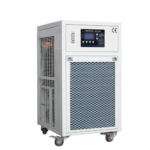
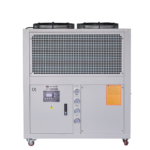
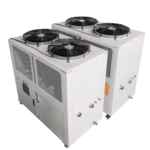

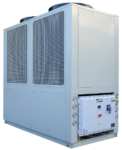

Water-Cooled Chillers
Kaydeli’s water-cooled chillers are designed to meet the specific needs of different industries, ensuring reliable and consistent cooling for industrial operations, air conditioning, or heating applications. The chiller’s compact and innovative design combined with cooling towers, low noise and efficient operation makes Kaydeli’s water-cooled chillers the ideal choice for a broad range of industrial applications, including manufacturing, data centers, and medical imaging systems.

Air-Cooled Chillers
Kaydeli air-cooled chillers are another high-performance option that conserves energy while providing reliable cooling. They are compact and can be installed indoors or outdoors, thanks to their high-quality corrosion-resistant coating and stainless steel parts. The Air-cooled chillers are easy to maintain and operate due to their low vibration noise, highly efficient compressors and large heat exchange area.
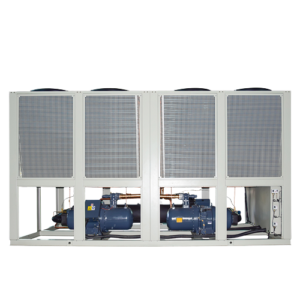
Glycol Chillers
Kaydeli’s glycol chiller is a tried-and-tested cooling solution that provides uniform heat dissipation at low temperatures for a wide range of production operations. These chillers come with user-friendly controls, high-quality components to ensure resistance to wear and corrosion, and advanced design to reduce noise pollution associated with industrial cooling.
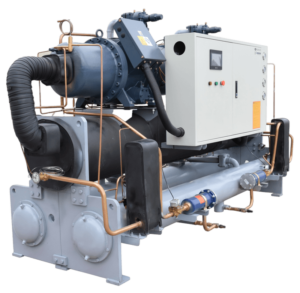
CO2 Laser Chillers
Kaydeli’s CO2 laser chillers are top-of-the-range chillers designed for high-precision cooling essential for CO2 laser machines. Their robust design ensures reliable and stable performance, ensuring that CO2 lasers work appropriately by providing the correct cooling capacities.
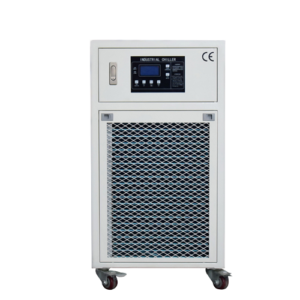
Oil-Cooled Chillers
Kaydeli’s oil-cooled chillers are made for similar industrial applications where applications and equipment need to be cooled and lubricated such as CNC, Hydraulic equipment. These chillers have efficient oil temperature control and flow rate control to ensure stable and reliable equipment operation while ensuring the smooth running and long life of the equipment.
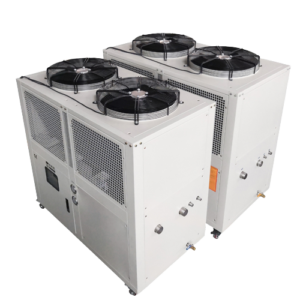
Chillers for AHU/FCU
Air handling units (AHU) and fan coil units (FCU) are common HVAC applications that require reliable, energy-efficient chillers. Kaydeli offers industrial chillers that are specifically designed to meet the requirements of HVAC contractors and architects for specific projects. The chiller’s efficient systems, flexible design, and accurate temperature controls make them an ideal choice for large commercial facilities, hospitals, and critical manufacturing processes.
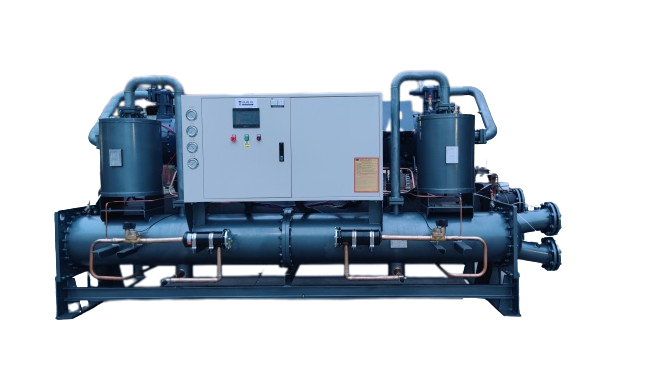
Chillers for the Manufacturing Industry
Kaydeli’s manufacturing chillers are designed for various industrial applications, such as food processing, and chemical, and pharmaceutical manufacturing. They feature advanced technology for efficient operation, reduced noise emission, and lower energy usage during operation, providing significant savings in manufacturing costs.
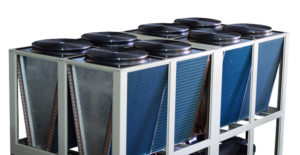
Laboratory Chillers
Kaydeli’s laboratory chillers are designed for precision temperature control of scientific instruments and research equipment in laboratory environments. These chillers are compact, can be adapted to a wide range of laboratory equipment, and provide high accuracy temperature control, minus vibrations, and noise, and less maintenance cost.

In conclusion, Kaydeli industrial chillers provide reliable, efficient, and eco-friendly cooling solutions for different industrial requirements. Industries such as manufacturing, construction, and laboratories stand to benefit from these chiller ranges with their high-quality components, advanced technology, reduced energy usage, and easy operation. With multiple chillers to choose from, it is easy to find one that fits your specific industry needs.
Sources:
Why explosion-proof chillers are important?
Explosion-proof chillers are an essential component of many industrial settings, particularly those that deal with potentially hazardous materials. In this blog, we’ll explore the uses and importance of explosion-proof chillers, with a particular focus on Kaydeli’s explosion-proof chiller and its applications in the chemical manufacturing and nuclear reactor plant industries.
Explosion-proof chillers are designed to prevent explosions in hazardous environments by using specialized components and materials. They are typically used in industries that deal with flammable gases, vapors, or liquids, such as chemical manufacturing and nuclear reactor plants.
One of the key benefits of explosion-proof chillers is that they can help to prevent accidents and protect workers from harm. By using specialized components and materials, these chillers are able to operate safely in hazardous environments, reducing the risk of explosions or other incidents.
Kaydeli’s explosion-proof chiller is a prime example of this type of chiller. It is designed to meet the needs of industries that require explosion-proof equipment, and it is known for its reliability and efficiency. This chiller is capable of cooling down even the most hazardous materials, ensuring that workers are protected and the environment is safe.
In the chemical manufacturing industry, explosion-proof chillers are used to cool down chemicals during the manufacturing process. This is important because many chemicals can become volatile if they get too hot, which can lead to explosions or other incidents. By using an explosion-proof chiller, chemical manufacturers are able to maintain a consistent temperature for their chemicals, reducing the risk of accidents and ensuring that the manufacturing process is efficient and effective.
In the nuclear reactor plant industry, explosion-proof chillers are used to cool down the reactor and other equipment. This is important because nuclear reactors generate a significant amount of heat, and if this heat is not managed properly, it can lead to accidents or other incidents. By using an explosion-proof chiller, nuclear reactor plants are able to maintain a consistent temperature for their equipment, reducing the risk of accidents and ensuring that the plant operates safely and efficiently.
In conclusion, explosion-proof chillers are an essential component of many industrial settings, particularly those that deal with hazardous materials. Kaydeli’s explosion-proof chiller is a reliable and efficient option for industries that require explosion-proof equipment, and it has numerous applications in the chemical manufacturing and nuclear reactor plant industries. By using this type of chiller, industries can protect their workers and the environment, while also ensuring that their equipment operates safely and efficiently.
Sources:
Why Oil cooled chillers are important for CNC machines
CNC and hydraulic machines are essential tools in many industrial settings, and they require a reliable cooling system to maintain optimal performance. This is where oil-cooled chillers come in. In this article, we’ll explore the importance of oil-cooled chillers and the different types of chillers used for CNC and hydraulic machines.
Oil-cooled chillers are designed to cool down the oil that is used to lubricate and cool down the machines. This is important because the oil can become too hot, which can lead to damage to the machines and a decrease in performance. By using an oil-cooled chiller, the oil can be kept at a consistent temperature, which helps to prolong the life of the machines and maintain their performance.
There are several types of oil-cooled chillers that are commonly used for CNC and hydraulic machines. These include:
Air-cooled oil chillers: These chillers use air to cool down the oil. They are typically less expensive than water-cooled chillers, but they are also less efficient.
Water-cooled oil chillers: These chillers use water to cool down the oil. They are more efficient than air-cooled chillers, but they are also more expensive.
Portable oil chillers: These chillers are designed to be portable, so they can be moved around as needed. They are typically smaller than other types of chillers, but they are still effective at cooling down the oil.
At Kaydeli, we offer a range of oil-cooled chillers that are specifically designed for CNC and hydraulic machines. Our chillers are known for their reliability, efficiency, and eco-friendliness. For example, our oil-cooled chiller units (from 1 ton to 30 tons) are designed to provide consistent cooling for CNC and hydraulic machines, ensuring optimal performance and longevity.
In conclusion, oil-cooled chillers are an essential component of any industrial setting that uses CNC and hydraulic machines. By maintaining a consistent temperature for the oil, these chillers help to prolong the life of the machines and maintain their performance. At Kaydeli, we offer a range of oil-cooled chillers that are specifically designed for CNC and hydraulic machines, ensuring that our customers have access to the best possible cooling solutions for their needs.
How Chiller works on AHU
Air Handling Units (AHUs) are an important component of HVAC systems that are responsible for circulating air throughout a building. In order to maintain a comfortable and healthy indoor environment, it’s important that the air is kept at the right temperature and humidity levels. This is where Kaydeli AHU chillers come in – they are designed to provide reliable cooling solutions for AHUs, ensuring that the air supplied to a building is comfortable and healthy.
How does a Kaydeli AHU chiller work?
A Kaydeli AHU chiller works by circulating chilled water through the AHU. The chiller contains a refrigeration cycle that is used to cool the water, which is then circulated through the AHU’s cooling coil. The cooling coil removes heat and moisture from the air that is passed over it, resulting in cool, dry air that is then supplied to the building’s HVAC system.
The refrigeration cycle in a Kaydeli AHU chiller typically includes four key components: a compressor, a condenser, an expansion valve, and an evaporator. The compressor is responsible for compressing the refrigerant gas, which raises its temperature and pressure. The high-pressure gas is then passed through a condenser, which removes heat from the gas and converts it into a high-pressure liquid.
The high-pressure liquid is then passed through an expansion valve, which reduces its pressure and temperature. The low-pressure liquid is then passed through an evaporator, where it absorbs heat from the water that is circulated through the chiller. The heat absorbed by the refrigerant is then carried away by the compressor, which starts the cycle over again.
The chiller’s microcomputer controller is responsible for regulating the temperature of the chilled water that is circulated through the AHU. The controller monitors the temperature of the chilled water and adjusts the operation of the chiller’s components as needed to maintain the desired temperature. The controller also includes safety features such as high and low-pressure protection, anti-freezing protection, and power-off protection to ensure safe and reliable operation.
The whole mechanism of the chiller in an AHU
The whole mechanism of a Kaydeli AHU chiller in an AHU involves several key components that work together to provide reliable cooling. The chiller itself is typically housed in a mechanical room or basement and is connected to the AHU by a series of pipes that circulate the chilled water.
The chiller’s compressor is typically driven by an electric motor and is responsible for compressing the refrigerant gas. The refrigerant gas is then passed through the condenser, which removes heat from the gas and converts it into a high-pressure liquid.
The high-pressure liquid is then passed through an expansion valve, which reduces its pressure and temperature. The low-pressure liquid is then passed through the evaporator, which absorbs heat from the water that is circulated through the chiller. The heat absorbed by the refrigerant is then carried away by the compressor, which starts the cycle over again.
The chiller’s microcomputer controller is responsible for monitoring and regulating the temperature of the chilled water that is circulated through the AHU. The controller adjusts the operation of the chiller’s components as needed to maintain the desired temperature, and includes safety features to ensure safe and reliable operation.
Overall, a Kaydeli AHU chiller is a reliable and efficient solution for cooling air in an AHU. By providing chilled water that is circulated through the AHU’s cooling coil, the chiller helps to maintain comfortable and healthy indoor environments for a wide range of applications.
For any kind of inquiries about the Kaydeli AHU chiller unit please feel free to contact us.



